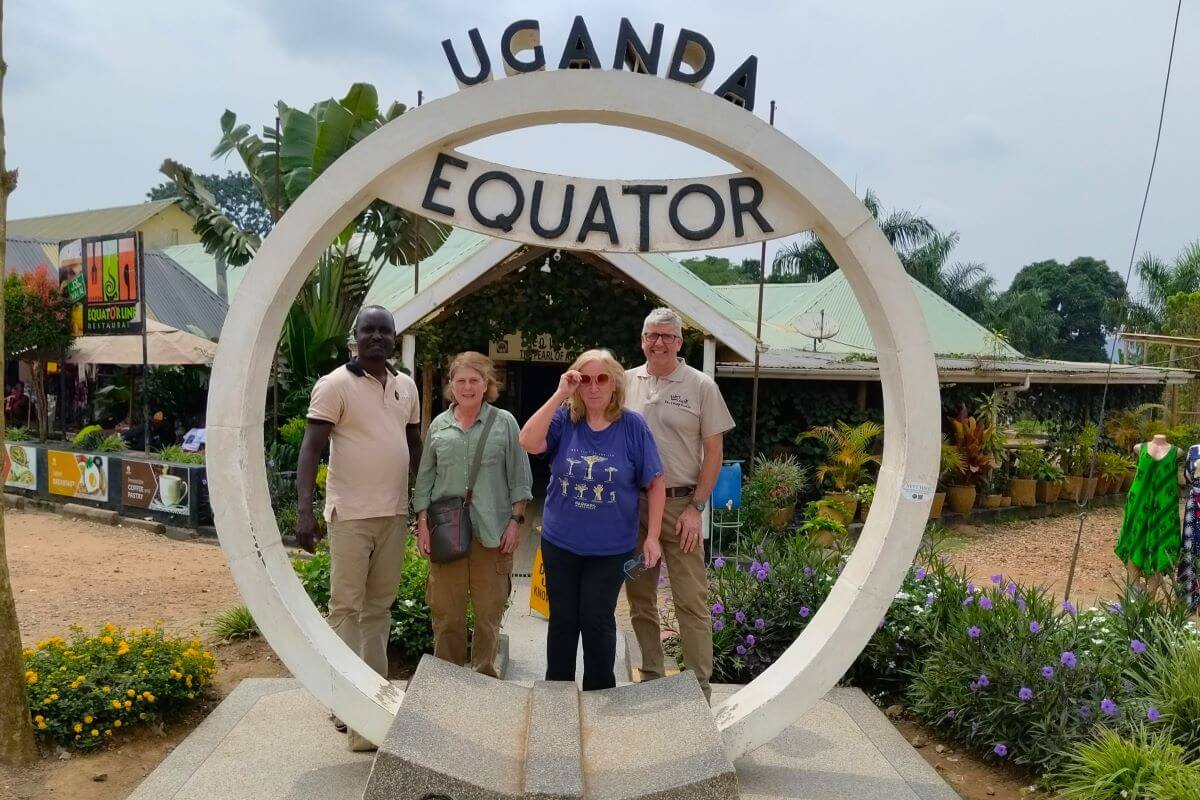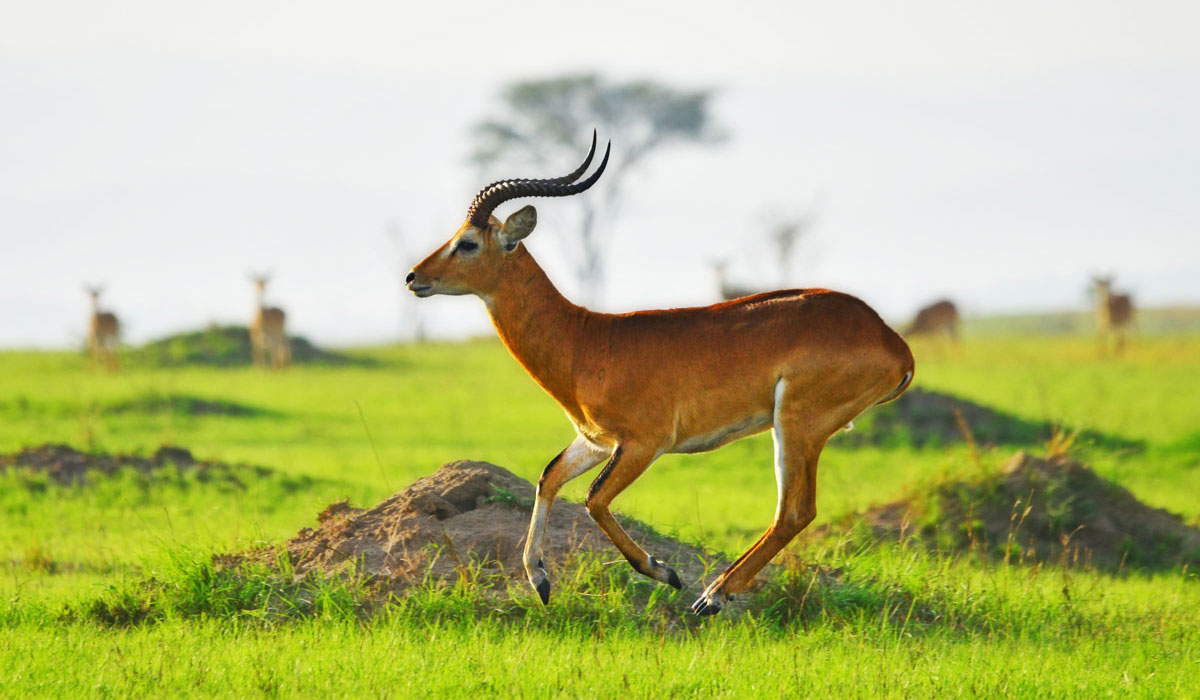Covering over 1,978 square kilometers in western Uganda, Queen Elizabeth National Park is known for its diverse landscapes, rich wildlife, and unique experiences. The park was established as a protected area in 1952 and named in honor of Queen Elizabeth II. As you step into Queen Elizabeth National Park, the first thing that strikes you is the vastness of its savannahs and plains dotted by acacia trees.
With the backdrop of the Rwenzori Mountains, the park’s scenic views include dozens of explosive craters, the lush forests in Kyambura Gorge with a thriving population of chimpanzees, the Kazinga Channel with its banks lined with hippos, buffalo, and elephants, and the endless Ishasha plains, whose fig trees hide lions.
The Kasenyi Plains, in particular, are a highlight, with their golden grasses swaying in the breeze and providing a picturesque backdrop for wildlife sightings.
Queen Elizabeth National Park is home to an impressive variety of wildlife. For classic game drives, the tracks through Kasenyi, the North Kazinga Plains, and the Ishasha Sector offer guaranteed buffalo, antelope, and elephant sightings, along with warthogs and baboons.
Taking an experienced guide in the early morning or at dusk is the most successful way to track down a pride of lions, and maybe even the odd leopard. The thrill of spotting these creatures in their natural habitat is an experience that lingers long after your safari ends.

Marvel at the congregations of hippos, crocodiles, and water birds while on a boat cruise on the Kazinga Channel.
The Kazinga Channel is an oasis for many of the fascinating species that inhabit Queen Elizabeth National Park, and taking a boat tour along it gives visitors the chance to cruise just meters from hundreds of hippos and buffaloes while elephants and crocodiles linger on the shoreline.
Don’t forget to carry your camera as the photo opportunities are many.

Kyambura Gorge, also known as the Valley of Apes, is a gorge carved by the Kyambura River. The gorge is covered by a lush rainforest and is home to a thriving population of chimpanzees.
Guided primate tracking excursions provide a unique opportunity to witness these intelligent beings in their natural habitat, swinging from tree to tree and engaging in their social behaviors.
The Kyambura Gorge experience is more than discovering chimpanzees in their natural environment: it teaches visitors about the ecosystems of Kyambura Gorge’s atmospheric “underground” rainforest, including vegetation types, bird identification and behavior, and chimp and monkey ecology.
Although chimp sightings are not guaranteed, visitors stand a pretty good chance of hearing and seeing our distant cousins.
For avid birdwatchers, Queen Elizabeth National Park is nothing short of a paradise. The park was classified as an Important Birding Area (IBA) by Birding International with over 600 species of birds including various migratory species.

Key species include the Martial Eagle, Black-rumped Buttonquail, African Skimmer, Chapin’s Flycatcher, Pink-backed Pelican, African Broadbill, Verreaux’s Eagle Owl, Black Bee-eater, White-tailed Lark, White-winged Warbler, Papyrus Gonolek, Papyrus Canary, Corncrake, Lesser and Greater Flamingo, Shoebill, Bar-tailed Godwit.
For the best birding in Queen Elizabeth National Park, don’t miss these birding hot spots:
Kazinga Channel, Kasenyi Area, Mweya Peninsula, Maramagambo Forest, Ishasha Sector, Lake Kikorongo, Katunguru Bridge area and Katwe Area.
Tucked beneath the shady canopy of the Maramagambo Forest is the “Bat Cave”. The cave has a viewing room built through funding from the CDC in which visitors can observe the bats as well as the pythons that live alongside them.
For a more cultural cave experience, how about a trip to the historic cave at Nyanz’ibiri community, where a local guide will explain to you how it was once used for offering sacrifices and cleansing misfortune and as a hiding place during Uganda’s rule by Idi Amin?
Dotted throughout the park are numerous crater lakes. The crater lakes are a result of ancient volcanic activity, creating a series of circular depressions that have since evolved into stunning bodies of water.
Each lake has its own unique charm, ranging from the deep blue hues of Lake Nyamunuka to the emerald green waters of Lake Munyanyange. The lakes are scattered across the landscape, offering a sense of discovery as you navigate the winding paths that lead to these hidden gems.
Queen Elizabeth National Park is easily accessible by both road and air. The park is 370 kilometers west of the capital, Kampala approximately a 5-6 hour drive with well-maintained roads leading to its various entry points.
For those seeking a quicker option, domestic flights are available to the park’s airstrips from Entebbe or any of the other national parks around Uganda.
Queen Elizabeth is well located near other Ugandan attractions such as Kibale, Bwindi, Rwenzori, Semuliki, and Lake Mburo National Park. This makes it ideal as part of a trip that visits more than one location in western and southwestern Uganda.
Queen Elizabeth National Park provides a range of accommodation options to suit every traveler’s preference. From luxury lodges with stunning views to cozy campsites, the park caters to various budgets and tastes.
Queen Elizabeth Park Entry Fees
| Category | Foreign (Non-residents) USD. | Foreign (Residents) Usd. | Rest Of Africa Usd. | East African citizens (Ug.shs) |
| Adult | 40 | 30 | 25 | 20,000 |
| Child | 20 | 10 | 5 | 5,000 |
| Boat | 30 | 30 | 30 | 30,000 |
| Nature Walk | 40 | 40 | 40 | 30,000 |
| Night game drive | 25 | 25 | 25 | 25,000 |
| Cycling |
Here are some of our safari packages that include a visit to Queen Elizabeth National Park for wildlife viewing, chimpanzee tracking, birding, launch cruises, and more.















